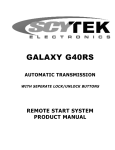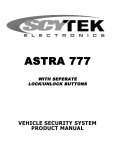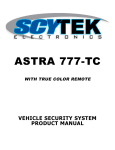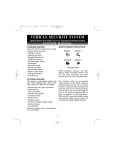Download Scytek electronic 600 Product manual
Transcript
600 SERIES VEHICLE SECURITY SYSTEM PRODUCT MANUAL Limited Lifetime Warranty This vehicle security system is warranted to the original purchaser, to be free from defects in material and workmanship. The manufacturer will repair or replace at its option, and free of charge for the first twelve (12) months, any part that proves defective in material or workmanship under normal installation, use, and service, provided the product is returned to the manufacturer freight prepaid. After the first 12 month warranty period there will be a maximum service charge of $25.00 per calendar year (if required) for repair and/or replacement of any defective parts. A copy of the original purchase receipt must accompany any products returned for warranty service. Warranty is limited to defective parts and/or replacement parts only and excludes any incidental, and consequential damages connected therewith. The manufacturer of this theft deterrent system makes no warranty against the theft of the vehicle or its contents. This warranty is not to be construed as an insurance policy against loss. WARRANTY OF INSTALLATION LABOR, REMOVAL AND RE-INSTALLATION CHARGES ARE NOT THE RESPONSIBILITY OF THE MANUFACTURER. Table of Contents 1. 2. 3. 4. 5. 6. 7. 8. 9. 10. 11. 12. About Your System . . . . . . . . . . . . . . . . . . . . . . . . . . . . . . . . . . . . . . . . . . . . . . . . . . . .Page 1 Remote Transmitters . . . . . . . . . . . . . . . . . . . . . . . . . . . . . . . . . . . . . . . . . . . . . . . . . . .Page 2 Remote Transmitter Description . . . . . . . . . . . . . . . . . . . . . . . . . . . . . . . . . . . . . . .Page 2 Adding/Replacing Transmitters . . . . . . . . . . . . . . . . . . . . . . . . . . . . . . . . . . . . . . . .Page 3 Two Car Operation . . . . . . . . . . . . . . . . . . . . . . . . . . . . . . . . . . . . . . . . . . . . . . . .Page 3 Battery Replacement . . . . . . . . . . . . . . . . . . . . . . . . . . . . . . . . . . . . . . . . . . . . . .Page 3 System Operation . . . . . . . . . . . . . . . . . . . . . . . . . . . . . . . . . . . . . . . . . . . . . . . . . . . . .Page 4 Remote Arming . . . . . . . . . . . . . . . . . . . . . . . . . . . . . . . . . . . . . . . . . . . . . . . . . .Page 4 Remote Disarming . . . . . . . . . . . . . . . . . . . . . . . . . . . . . . . . . . . . . . . . . . . . . . . .Page 4 Tamper Alert . . . . . . . . . . . . . . . . . . . . . . . . . . . . . . . . . . . . . . . . . . . . . . . . . . . .Page 5 Silent Arming/Disarming . . . . . . . . . . . . . . . . . . . . . . . . . . . . . . . . . . . . . . . . . . . .Page 5 Passive Arming . . . . . . . . . . . . . . . . . . . . . . . . . . . . . . . . . . . . . . . . . . . . . . . . . .Page 5 Panic Mode . . . . . . . . . . . . . . . . . . . . . . . . . . . . . . . . . . . . . . . . . . . . . . . . . . . . .Page 6 Emergency Override . . . . . . . . . . . . . . . . . . . . . . . . . . . . . . . . . . . . . . . . . . . . . . .Page 6 Optional Coded Emergency Override . . . . . . . . . . . . . . . . . . . . . . . . . . . . . . . . . . . .Page 6 Automatic Rearming . . . . . . . . . . . . . . . . . . . . . . . . . . . . . . . . . . . . . . . . . . . . . . .Page 7 Valet Mode . . . . . . . . . . . . . . . . . . . . . . . . . . . . . . . . . . . . . . . . . . . . . . . . . . . . .Page 7 Extended Features . . . . . . . . . . . . . . . . . . . . . . . . . . . . . . . . . . . . . . . . . . . . . . . . . . . .Page 8 Ignition Controlled Door Locks . . . . . . . . . . . . . . . . . . . . . . . . . . . . . . . . . . . . . . . .Page 8 Dome Light Activation . . . . . . . . . . . . . . . . . . . . . . . . . . . . . . . . . . . . . . . . . . . . .Page 8 Auxiliary Function Outputs . . . . . . . . . . . . . . . . . . . . . . . . . . . . . . . . . . . . . . . . . .Page 8 Disarm with Auxiliary Function . . . . . . . . . . . . . . . . . . . . . . . . . . . . . . . . . . . . . . . .Page 8 Remote Sensor Disable . . . . . . . . . . . . . . . . . . . . . . . . . . . . . . . . . . . . . . . . . . . . .Page 8 Anti-Carjacking Protection . . . . . . . . . . . . . . . . . . . . . . . . . . . . . . . . . . . . . . . . . . .Page 8 System Installation . . . . . . . . . . . . . . . . . . . . . . . . . . . . . . . . . . . . . . . . . . . . . . . . . . . .Page 9 Mounting the Control unit . . . . . . . . . . . . . . . . . . . . . . . . . . . . . . . . . . . . . . . . . .Page 10 Mounting the Siren . . . . . . . . . . . . . . . . . . . . . . . . . . . . . . . . . . . . . . . . . . . . . . .Page 10 Mounting the Shock Sensor . . . . . . . . . . . . . . . . . . . . . . . . . . . . . . . . . . . . . . . . .Page 10 System Wiring . . . . . . . . . . . . . . . . . . . . . . . . . . . . . . . . . . . . . . . . . . . . . . . . . . . . . .Page 11 15-Pin Main Harness . . . . . . . . . . . . . . . . . . . . . . . . . . . . . . . . . . . . . . . . . . . . . .Page 11 5 Pin Door Lock Harness . . . . . . . . . . . . . . . . . . . . . . . . . . . . . . . . . . . . . . . . . . .Page 11 Starter Defeat Conncectors . . . . . . . . . . . . . . . . . . . . . . . . . . . . . . . . . . . . . . . . .Page 12 Plug-in Connectors . . . . . . . . . . . . . . . . . . . . . . . . . . . . . . . . . . . . . . . . . . . . . . .Page 12 Jumper Settings . . . . . . . . . . . . . . . . . . . . . . . . . . . . . . . . . . . . . . . . . . . . . . . . . . . . .Page 13 System Programming . . . . . . . . . . . . . . . . . . . . . . . . . . . . . . . . . . . . . . . . . . . . . . . . .Page 14 Entering System Programming . . . . . . . . . . . . . . . . . . . . . . . . . . . . . . . . . . . . . . .Page 14 Default Reset . . . . . . . . . . . . . . . . . . . . . . . . . . . . . . . . . . . . . . . . . . . . . . . . . .Page 14 Programmable System Options . . . . . . . . . . . . . . . . . . . . . . . . . . . . . . . . . . . . . . .Page 14 Branch Table . . . . . . . . . . . . . . . . . . . . . . . . . . . . . . . . . . . . . . . . . . . . . . . . . . .Page 14 Door Lock Diagrams . . . . . . . . . . . . . . . . . . . . . . . . . . . . . . . . . . . . . . . . . . . . . . . . . .Page 16 Two Stage Door Lock Diagrams . . . . . . . . . . . . . . . . . . . . . . . . . . . . . . . . . . . . . . . . . .Page 17 Technical Information . . . . . . . . . . . . . . . . . . . . . . . . . . . . . . . . . . . . . . . . . . . . . . . . .Page 19 Wiring Diagram . . . . . . . . . . . . . . . . . . . . . . . . . . . . . . . . . . . . . . . . . . . . . . . . . . . .Back Page About Your System Congratulations on your purchase of this state-of-the-art vehicle security system from ScyTek Electronics. With proper installation this system will provide superior protection and performance for many years to come. System Contents: • • • • • • Main Unit Two 5-Button Random Code Remote Transmitters High Output 6-tone Siren Dual Stage Shock Sensor Status LED Coded Valet Switch Options and Accessories* This ScyTek system includes several optional inputs and outputs allowing the creation of a completely personalized security and convenience system by offering many optional features such as: · · · · · · · · Second Car Operation Remote Door Locking Two Stage Door Unlocking Starter Defeat Horn Honk Illuminated Entry Remote Window Control Remote Car Start · · · · · · · · Extended Range Antenna Power Trunk / Hatch Release Glass Breakage Sensor Radar Sensor Auxiliary Lighting Control Stereo System Valet Remote Head Lamp Control Back-up Battery Siren *May require additional parts and/or labor, see store for details. PLEASE NOTE: Some of the features described in this manual may require additional parts and/or labor, and may not be included as part of the standard installation of this unit. Additionally, many features of this security system have selectable options that must be activated or programmed during the system’s installation. These items will be identified in the following sections. Please discuss these features and any questions you may have regarding the installation of this product with Your Authorized Dealer. Astra 600 - Page 1 Remote Transmitters Remote Transmitter Description LED Button 1 Button 2 Button 5 Button 3 Button 4 The Astra 600 is supplied with two 5-button Remote Transmitters used to control system operations. Button 1 Arms the system and when held for 2 seconds, activates the system’s Panic feature. Button 1 also locks the doors when the system is in Valet Mode. Button 2 Disarms the system. Pressing Button 2 again operates the Passenger Unlock feature (if installed). Button 2 also unlocks the doors when the system is in Valet Mode. Button 3 Activates the Auxiliary 1 output. This output will remain on for as long as the button is pressed. Button 4 Activates the Auxiliary 2 output. This output will remain on for as long as the button is pressed. Button 5 is the Page Shift button. The Page Shift button will change the function of Buttons 1 through 4 each time it is pressed, allowing access to additional features or multiple car operation. Each time the Shift Button is pressed, the LED on the transmitter will illuminate and the transmitter functions will shift to the next page, allowing access to another set of features. Once shifted to another page (there are 4 pages total), the transmitter will remain on that page for 10 seconds or until a button is pressed, then return to page 1. Each time a transmitter button is pressed and held, the LED will flash a number of times to indicate from which page it is transmitting. Under normally operation, only pages 1 and 2 are used. Pages 3 and 4 are usually used for Two Car Operation (see page 3). Shift then Button 1 Arms the system silently. Shift then Button 2 Disarms the system silently. Shift then Button 3 Activates the Auxiliary 3 output. This output will remain on for as long as the button is pressed. Shift then Button 4 Activates the Vehicle Locator feature which flashes the parking lights and chirps the siren 5 times. This feature is useful to help locate the vehicle in a crowded parking lot. Page 2 - Astra 600 Adding/Replacing Transmitters To replace lost or stolen transmitters or to add additional transmitters into the system, have all desired transmitters ready and follow the steps below. Note: Up to 4 transmitters can be programmed to operate the system. To erase any previously stored transmitter codes, be sure to program all 4 transmitter memory locations. To program the transmitter(s): 1. Turn on the ignition key On, Off, On, Off, and back On. · The siren will chirp 3 times. 2. Press and hold the Override switch for 5 seconds. · The siren will chirp 5 times. · The LED will illuminate. 3. Press Button 1 on the first transmitter. · The siren will chirp once. 4. Press Button 1 on the first transmitter again. · The siren will chirp twice to indicate it has learned the code. 5. Repeat steps 3 and 4 for each transmitter (up to 4). 6. Turn off the ignition key. Two Car Operation If two vehicles are equipped with Astra 600 systems, for convenience both can be operated using the same remote transmitter. If all four transmitters are to be used with both cars, program transmitters A and B into the first vehicle in the manner described above. Program transmitters C and D by pressing the Shift button twice before performing steps 3 and 4 above. When finished programming the first vehicle, program transmitters C and D into the second vehicle as normal, then program transmitters A and B by pressing the Shift button twice before performing steps 3 and 4 above. When programmed in this manner, the driver of the first car can also operate the second vehicle by pressing the Shift button twice and the desired function button. Battery Replacement Your Remote Transmitter uses a 12 volt alkaline battery (type 23A), which will require replacement in time. Depending on the amount of use, the battery may last up to six months or more before it needs replacement. When the battery needs replacing, the system’s operating range will decrease or the transmitter LED may not be as bright. In order to change the battery, first remove 2 screws from the back of the transmitter and separate the top and bottom halves of the case. While replacing the battery make sure that the positive and negative terminals are positioned correctly, then carefully reassemble the transmitter case. Astra 600 - Page 3 System Operation Remote Arming The system monitors 4 independent areas (zones) while armed: doors, hood/trunk, shock sensor and optional sensor input. To Arm the System: 1. Turn off the ignition. 2. Press Button 1. · The siren will chirp once.* · The doors will lock. · The parking lights will flash once. · The LED will turn on red, to indicate the starter defeat is activate. 3. 5 seconds after Arming: · The LED will start blinking to indicate that the doors and hood/trunk inputs are being monitored. * During Arming, if the system detects a bad sensor or an open zone, the system will chirp 4 additional times and ignore that input, but keep all other areas protected. Once Armed, the alarm will trigger when any of the following occurs: · The doors are opened. · The hood or trunk is opened. · The shock sensor detects an impact to the vehicle. · The optional sensor is disturbed. When the alarm triggers, the siren will sound, the horn will honk, and the parking lights will flash. If the system is triggered by the doors, or hood/trunk, the system will alarm for 45 seconds. If triggered by the shock sensor or optional sensor input, the system will alarm for 30 seconds. In the event the alarm is triggered and remains triggered continuously by the same sensor or input during a single arming cycle, that sensor or input will be automatically bypassed until the next time the system is armed. If the Shock Sensor detects a light impact to the vehicle, or the Optional Sensor’s warnaway zone is disturbed, the siren will chirp 5 times as a warning indication. Remote Disarming To Disarm the System: Press Button 1. · The siren will chirp twice.* · The doors will unlock. · The parking lights will flash twice. · The dome light will turn on. · The LED will turn off. * During Disarming, if the system was triggered while away from the vehicle, the siren will chirp 3 times, the parking lights will flash 3 times, and the LED will flash to indicate triggered zone. See Tamper Alert for zone listing. Page 4 - Astra 600 Tamper Alert If the system was triggered while away, the LED will flash to indicate which zone triggered the system after disarming and turning on the ignition. The LED indication will repeat 8 times. LED Flashes: 1 flash 2 flashes 3 flashes 4 flashes 5 flashes 10 flashes = = = = = = optional sensor shock sensor not used door trunk main power interrupt or system was reset example: flash-flash-pause-flash-flash-pause = shock sensor Silent Arming/Disarming The system can be programmed to operate without Arm and Disarm chirp indications. When programmed for full-time silent operation, the siren will sound only when the system is triggered. The system is also capable of temporary silent operation if desired. Pressing the Shift button before Arming or Disarming the system will bypass the chirp confirmations and allow one-time silent operation. Note: The open zone warning chirps will not be bypassed when the system is Armed or Disarmed silently. Passive Arming When programmed for the optional Passive Arming feature, the system arms itself automatically, each time the ignition is turned off and all of the doors, hood, and trunk are closed. To start the Passive Arming Process: 1. Turn off the ignition.* 2. Open the door and exit the vehicle. · Once all doors are closed and the dome light is off, the LED will begin flashing rapidly. 3. After 30 seconds, · The siren will chirp. · The parking lights will flash. · The doors will lock.** · The status LED will begin flashing. 4. The system is now armed. * The ignition must have been on for at least 5 seconds or the Passive Arming sequence will be disabled. ** If the Passive Locking feature is selected. To temporarily disable Passive Arming, turn on the ignition then turn off within 5 seconds. The siren will chip once indicating the system will not passively arm until the ignition is cycled again. If the Passive Arming with Countdown feature is programmed, the siren will chirp every 2 seconds until the system passively arms. Note: If the Passive Arming feature is enabled, the Automatic Rearming feature will also be enabled even if it was not already programmed. Astra 600 - Page 5 Panic Mode In the event of an emergency the transmitter’s remote Panic feature can be used to instantly trigger the alarm. To activate the Panic Mode: 1. Press and hold Button 1 for 3 seconds. · The alarm will sound. · The parking lights will flash. · The doors will unlock* allowing access to the vehicle. 2. Press Button 2 to stop Panic Mode. * If the ignition is on when the Panic feature is activated, the doors will lock for personal safety. Emergency Override If the transmitter becomes lost or inoperable, the system can still be disarmed using the following procedure. Before beginning this procedure be sure to have the ignition key ready and know the location of the override switch. To Emergency Override the system: 1. Unlock the door using the key. 2. Enter the vehicle. · The system will trigger and the siren will sound. 3. Turn ignition key on. 4. Press and hold the override switch for 10 seconds. · The system will disarm. 5. The vehicle will now be able to start. Optional Coded Emergency Override As an extra measure of security, the system is equipped with an optional Coded Emergency Override feature. Once an Emergency Override Code is chosen and programmed during installation, the system can no longer be disarmed using the standard override procedure. To Emergency Override the system using the Code: 1. Follow steps 1-3 above. 2. Press the override switch a number of times equal to the Disarm code, and continue holding for 10 seconds on the last press. · The system will disarm. If the code is entered incorrectly, turn off the ignition and begin again. To set the Emergency Override Code: 1. Turn on ignition. 2. Within 5 seconds, press the valet switch 5 times. · The siren will provide one long chirp, indicating that you have entered Programming. 3. Press the valet switch 3 times. · The siren will chirp each time the valet switch is pressed. 4. Within 5 seconds, press Button 3 on the transmitter. · The siren will chirp 3 times. Page 6 - Astra 600 5. Press the valet switch the number of time equal to the desired code (from 1-15). 6. Turn off the ignition then arm the system. 7. Disarm the system using the new Override Code to permanently store the new code. Note: If the code set procedure is not properly performed, turn off the ignition and begin again. The override code will not be permanently stored until the code is used to disarm the system. Automatic Rearming The automatic Rearming feature is designed to protect the vehicle in the event the system is accidentally disarmed. With the Automatic Rearming feature enabled, the alarm will automatically rearm 30 seconds after disarming. If the optional Passive Door Locking feature is enabled, the doors will also lock when the system rearms. The Automatic Rearming feature will be temporarily bypassed until the next arming cycle if the ignition is turned on or the trunk/hood zone is opened. Valet Mode The Valet Mode temporarily disables the security system so the vehicle may be operated by a mechanic or parking attendant. To activate or deactivate the Valet Mode: 1. Turn on the ignition. 2. Press and hold the override switch for 5 seconds. · The siren will chirp once to confirm the Valet Mode is on. · The siren will chirp twice to confirm the Valet Mode is off. 3. Turn off the ignition. While in Valet Mode the remote transmitters will continue to lock and unlock the doors, and operate the optional auxiliary functions. Astra 600 - Page 7 Extended Features Ignition Controlled Door Locks For added safety, the Ignition Door Locking feature allows vehicles equipped with power door lock systems to automatically lock the doors when the ignition is turned on, and unlock the doors after the ignition key is turned off. If a door is open when the ignition is turned on, the ignition locking feature is disabled to protect against locking the keys inside the vehicle. Dome Light Activation If the optional Dome Light Activation feature is installed, the dome light will turn on when the system is disarmed using the Remote Transmitter. The dome light will remain on for 30 seconds or until the ignition is turned on. Auxiliary Function Outputs The Astra 600 system is equipped with 3 Auxiliary Outputs allowing the convenience features of the system to be further expanded. These outputs can be used to add a number of optional features such as: power trunk release, remote engine start, power window activation, power sunroof control, and more. Disarm with Auxiliary Function If Auxiliary 1 is installed to activate the vehicle’s trunk release, the system can be programmed to automatically disarm the alarm when the trunk is opened using the transmitter. In this manner, the trunk can be accessed without first disarming the alarm. Remote Sensor Disable When parking the vehicle in areas susceptible to unwanted disturbance from animals or strong weather conditions that could cause the sensors to trigger, the sensor inputs can be temporarily bypassed using the Remote Transmitter, preventing possible false alarms. To disable the sensor inputs : 1. Arm the system normally. 2. Within 5 seconds of Arming the system, press the Arm button again. · The siren will chirp 5 times and the parking lights will flash 5 times to indicate the sensors are disabled. · The sensors will remain disabled until the next arming cycle. Anti-Carjacking Protection For a higher level of personal security, the system is equipped with three programmable AntiCarjacking modes. When any Anti-Carjacking mode is triggered, the parking lights will flash twice to confirm activation. After 90 seconds the siren will begin chirping for 15 seconds as a warning, prior to entering full alarm mode. During the full alarm mode, the siren will sound, the parking lights will flash, and the horn will honk for up to five minutes or until the system is reset. Manual. When selected, pressing Button 4 with the ignition on will automatically trigger the Anti-Carjacking feature. Press the Button 4 again to reset the Manual Anti-Carjacking mode. Passive. When selected, the Anti-Carjacking feature will activate whenever a door is opened while the ignition is on. Press the Valet swich 3 times to reset the Passive Anti-Carjacking mode. Full-Time. When selected, the Anti-Carjacking feature will automatically activate each time the ignition is turned on. Press the Valet swich 3 times while the ignition is on to reset the Passive Anti-Carjacking mode. Note: The desired Anti-carjacking mode must be programmed during installation. Page 8 - Astra 600 System Installation 1. Thoroughly read and become familiar with the installation instructions before beginning the installation. 2. Review system contents: Main Unit Two 5-Button Remote Transmitters Siren Shock Sensor Harnesses • • • • • • 15-Pin main harness 4-Pin shock sensor harness 5-Pin door lock harness Brown starter defeat relay wire LED harness Override Switch harness 3. Verify with the owner, the mounting locations for all visible components, including the LED and Override switch. 4. Verify with the owner, the optional features of the Astra 600 and the features that must be programmed during installation. 5. Inspect and perform a function test of all vehicle systems before and after the installation. 6. Always use a Volt / Ohm meter for testing vehicle circuits. Never use a test light. 7. Always look before drilling any holes or mounting self-tapping screws. Be sure fuel lines and exterior wiring looms are clear as they are often close to the chassis and difficult to see. 8. Protect all wires running from the engine compartment to the interior of the vehicle by covering with electrical tape and split loom tubing. Be sure to use a grommet when routing wires through the firewall. 9. Properly fuse any additional accessories such as window modules, door lock actuators, etc., making sure to power them separate from the alarm module. This will ensure the functionality of the security system in the event of an accessory failure. Astra 600 - Page 9 Mounting the Control Unit The control unit must only be mounted in the interior of the vehicle. Do not mount the main unit in the engine compartment. Choose a mounting location that will not be easily accessible to a thief, and will not interfere with the operation of any vehicle components such as foot pedals, steering column, air vents, seat rails, etc. Do not mount the control unit until after setting the internal jumpers and performing a complete operation check of the system. After installation is complete and performance verified, the control unit can be easily mounted using wire ties through the mounting tabs on the bottom of the unit. Mounting the Siren Choose a siren mounting location that is away from heat sources such as exhaust manifolds, and where it cannot be easily accessed from underneath the vehicle. Be sure to face the siren downward to prevent the collection of water in the siren’s housing. Always route all wires from the engine compartment into the interior of the vehicle through a proper grommet. Mounting the Shock Sensor Choose a suitable interior mounting location for the shock sensor that provides ample coverage of the vehicle. Keep the sensor away from the vehicle’s ECM or other sources of electrical interference. Suggested mounting locations include air conditioning ducts, dashboard braces, or center console supports. During proper operation, the shock sensor will detect impacts to the vehicle only and will not usually be triggered by slow rocking movements of the vehicle like those caused by wind. Page 10 - Astra 600 System Wiring 15-Pin Main Harness Pin 1 BLUE/WHITE: Passenger Unlock output (-) 500mA. Connect to an optional relay to unlock the passenger doors for two-stage unlock (see Two Stage Door Lock Diagrams). Pin 2 GRAY WIRE: Auxiliary 1 Output (+/–) 7A. Connect to an optional feature such as trunk release, etc. Pin 3 BLACK/YELLOW WIRE: Auxiliary 3 Output (-) 500mA. Connect to a relay or module for an optional feature such as power window activation or remote start, etc. Pin 4 BLACK/WHITE WIRE: Dome Light Relay Output (+/–) 7A. Connect to the wire that activates the vehicle’s dome light, usually the door pin switch wire. NOTE: The dome light output may usually connected to the same wire used for the door trigger input (See GREEN and VIOLET door trigger wires). Pin 5 RED WIRE: +12V Battery Input (15A Fuse). The Red wire must be connected to a clean source of continuous +12V power. Pin 6 BROWN WIRE: Siren Output (+) 3A. The BROWN wire must connect to the siren’s red wire. The BLACK siren wire must be grounded. Pin 7 VIOLET WIRE: Positive door trigger Input (+). Connect to the door switch circuit wire that shows +12V when the door is open. This type of door circuit is usually found on Ford vehicles. Pin 8 BLACK WIRE: Ground Input (-). The BLACK wire must connect to a solid chassis ground. Clean away any paint or dirt to insure the best possible ground. Pin 9 WHITE WIRE: Parking Light Output (+/–) 7A. The WHITE wire must connect to the circuit that shows +12V or ground when only the parking lights are on. For parking light circuits exceeding 7 amps, a relay is required. For vehicle’s with independent left and right parking light circuits, diodes must be used to keep the circuits separate. NOTE: Do not connect the WHITE wire to the vehicle’s headlight circuit. Pin 10 GREEN WIRE: Negative door trigger Input (-). Connect to the door switch circuit wire that shows ground when the door is open. Pin 11 YELLOW WIRE: +12V Ignition Input. The YELLOW wire must connect to a main ignition wire at the ignition harness. This wire must show +12V when the ignition is on. Pin 12 ORANGE WIRE: Armed Output (–) 500mA. The ORANGE wire provides a ground output while armed to activate an optional circuit defeat relay or other device such as a power window control module. Pin 13 WHITE/RED WIRE: Auxiliary 2 Output (-) 500mA. Connect to a relay or module for an optional feature such as power window activation or remote start, etc. Pin 14 BLUE WIRE: Trunk/Hood trigger Input (-). Connect the BLUE wire to the trunk and/or optional hood pin switches. The switch must provide a ground output when opened. Pin 15 BROWN/WHITE WIRE: Horn Output (-) 500mA. Connect to an optional relay to activate the vehicle’s horn when the alarm is triggered. 5-Pin Door Lock Harness Pin 1 Pin 2 Pin 3 Pin 4 Pin 5 WHITE WIRE: Lock Relay Pin 87a (Normally Closed). GREEN WIRE: Lock Relay Pin 30 (Common). BLUE WIRE: Unlock Relay Pin 30 (Common). BROWN WIRE: Unlock Relay Pin 87a (Normally Closed). VIOLET WIRE: Lock/Unlock Relays Pin 87 (Normally Open) [10A Fuse]. Astra 600 - Page 11 Starter Defeat Connectors Using a volt/ohm meter locate the starter wire (normally a heavier gauge wire) at the ignition switch. This wire will show +12V only during cranking. When this wire is cut the vehicle will be unable to start. Locate the BROWN starter disable wire included with the wiring harness and cut in half. After cutting the vehicle’s Connect one half to the cut side vehicle’s starter wire coming from the key switch. Connect the other BROWN wire to the wire going to the starter. Plug the female connectors on the BROWN wires to the .250 male spade lugs on the module. With the BROWN wires connected to the module, the vehicle should be able to start. Plug-in Connectors 2-Pin Red Connector: Plug-in connector port for LED. Mount the LED in an area where it may be easily seen from either side of the vehicle. 2-Pin Blue Connector: Plug-in connector port for valet switch. Mount the valet switch in an area that is easily accessible from the driver’s position. 4-Pin White Connector 1: Plug-in connector port for dual stage shock sensor. 4-Pin White Connector 2: Plug-in connector port for dual stage radar sensor. Page 12 - Astra 600 Jumper Settings Jumper Selections Carefully separate the top and bottom halves of the main unit case. Once the cover is removed, the polarity jumpers will be visible next to the parking light, dome light, and Auxiliary 1 relays. Set the jumpers for the correct polarity output as described below, then reassembly the main unit case. Parking Light Output. Selects the polarity (+/-) for the output of the on-board Parking Light relay. Left Pin + Center Pin = positive Right Pin + Center Pin = negative Dome Light Output. Selects the polarity (+/-) for the output of the on-board Illuminated Entry relay. Left Pin + Center Pin = negative Right Pin + Center Pin = positive Auxiliary 1 Output. Selects the polarity (+/-) for the output of the on-board Aux 1 relay. Left Pin + Center Pin = positive Right Pin + Center Pin = negative Parking Light Relay Lock Relay Dome Light Relay U Auxiliary 1 Relay HT LIG KIN G PA R O D E M L IG T H D 2N H C . default settings shown Astra 600 - Page 13 System Programming Entering System Programming To enter System Programming: 1. Turn on ignition. 2. Within 5 seconds, press the valet switch 5 times. · The siren will provide one long chirp, indicating that you have entered Programming. 3. Press the valet switch the number times equal to the System Option you want to change. · The siren will chirp each time the valet switch is pressed. 4. Within 5 seconds, press the transmitter button corresponding to the desired operating mode for that System Option. · The siren will chirp to indicate the setting. 1 chirp = Button 1 2 chirps = Button 2 3 chirps = Button 3 5. When you are finished, turn off the ignition to save the changes. Default Reset Following this procedure will set all Programmable System Options to factory default settings. 1. Enter System Programming. 2. Press Transmitter Button 3. · The siren will chirp 6 times indicating that the reset signal was received. · All Programmable System Options are now set to factory default settings. · The Valet Mode is off. · The Disarm Code is 1. 3. Turn off ignition. Programmable System Options Branch Feature 1. Horn Chirps w/ Arm&Disarm 2. Arm Mode 3. Passive Door Locking 4. Ignition Controlled Locks 5. Door Input Monitoring 6. Auto Rearming 7. Door Unlock Pulse 8. Arming Chirps 9. Extended Parking Lights 10. Disarm with Aux 1 11. Door Lock Pulse Length 12. Anti-Carjack Type 13. Anti-Carjack Mode 14. Ignition Armed Mode Button 1 (default) Normal Manual Arming Disabled On 10 Seconds Disabled Single Normal On Disabled 1 second Manual Disabled Disabled Button 2 Horn Chirps Passive Arming Enabled Off 60 Seconds Enabled Double Silent Off Enabled 3 seconds Passive Enabled Enabled Button 3 Horn Chirps w/Warn Passive w/Countdown Set Override Code Lock Only Full-time The following is a description of the programming options. Some program branches control more than one option, and may require accessing a particular branch number twice in order to program all desired features. Page 14 - Astra 600 1. Horn Chirps with Arm & Disarm. Selects one of three modes: Normal, Horn Chirps, and Horn Chirps w/Warn. Normal. When selected, the horn will honk only when the alarm is triggered. Horn Chirps. When selected, the horn will provide the arm/disarmand trigger indications, allowing the siren installation to be skipped. Horn Chirps w/Warn. When selected, the horn will provide arm/disarm, trigger, and warn-away indications. 2. Arm Mode. Selects one of three modes: Manual Arming or Passive Arming, and Passive Arming w/Countdown. With the Passive Arming w/Countdown mode selected, the siren will chirp every 2 seconds while counting down until the systempassively arms. Note: If Auto Rearming is selected, the siren will also chirp during Auto Rearm countdown. 3. Passive Door Locking / Override Code Set. This dual program branch sets Passive Locking and and programs the optional Emergency Override Code. Passive Door Locking. Selects whether or not the system will automatically lock the doors 5 seconds after the ignition key is turned on. Override Code Set. Changes the Emergency Override Code for a higher level of security (see page 6). 4. Ignition Controlled Locks. Selects whether or not the system will lock and unlock the doors with the ignition. If Lock Only is selected, the doors will not automatically unlock when the ignition is turned off. 5. Door Input Monitoring. Selects whether the system begins monitoring the door inputs after 10 seconds or 60 seconds. For vehicles with interior lights that remain on for an extended period of time after the doors are closed, set for 60 seconds. 6. Auto Rearming Mode. When selected, the system will automatically re-arm 30 seconds after it is disarmed if the doors have not been opened. 7. Door Unlock Pulse. Selects between one pulse or two pulse operation for the door unlock output. Vehicles that require two pulses on the proper wire to unlock the doors can be interfaced directly without the use of relays or any additional circuitry by programming the system for double unlock pulse. 8. Arming Chirps. Selects between normal and silent operation. 9. Extended Parking Lights. When selected, the parking lights will remain on for 30 seconds after disarming the system. 10. Disarm with Auxiliary 1. When selected, activating the Auxiliary 1 output (usually used to open the trunk) will disarm the alarm. 11. Door Lock Pulse Length. Selects between a 1-second and a 3-second output for door locking and unlocking. Program to 3 seconds for vehicles equipped with vacuum door locking systems. 12. Anti-Carjack Type. Selects one of three modes for Anti-Carjacking: Active, Passive, or Full-Time. Manual. When selected, pressing Button 4 with the ignition on will automatically engage the AntiCarjacking feature. Passive. When selected, the Anti-Carjacking feature will activate whenever a door is opened while the ignition is on. Full-Time. When selected, the Anti-Carjacking feature will automatically activate each time the ignition is turned on. 13. Anti-Carjack Mode. Enables Anti-Carjacking protection. 14. Ignition Armed Mode. When enabled, the security system may also be manually armed and disarmed using the transmitter, while the ignition is on. Astra 600 - Page 15 Door Lock Diagrams Follow the diagrams below for connecting basic door lock systems. For Two Stage door lock systems (separately unlocks driver and passenger doors) see following pages. Negative Trigger (-) Door Lock wire Positive Trigger (+) Door Lock wire FACTORY DOOR LOCK MODULE (-) Door Unlock wire DOOR LOCK SWITCH DOOR LOCK SWITCH White wire White wire NOT USED Green wire DOOR LOCK CONNECTOR DOOR LOCK CONNECTOR FACTORY DOOR LOCK MODULE (+) Door Unlock wire Blue wire Brown wire NOT USED Violet wire NOT USED Green wire Blue wire Brown wire NOT USED Violet wire +12V Reverse Polarity Vacuum DOOR LOCK CONNECTOR White wire CUT Green wire DOOR LOCK CONNECTOR White wire DOOR LOCK SWITCH Blue wire Brown wire Violet wire FACTORY MOTOR Blue wire Brown wire NOT USED Green wire 86 +12V Violet wire 87 85 87a 30 CUT +12V CUT DOOR LOCK SWITCH Adding Actuators AFTER-MARKET MOTORS DOOR LOCK CONNECTOR White wire Green wire Blue wire Brown wire Violet wire +12V Page 16 - Astra 600 VACUUM PUMP Two Stage Door Lock Diagrams The Astra 600 is equipped with a dedicated Passenger Unlock output allowing Two Stage Door Lock operation. When connected as shown below, disarming the system will unlock only the driver’s door. Pressing the disarm button again will unlock all doors. Two Stage Negative Trigger Blue/white wire (-) PASSENGER UNLOCK (-) Door Lock wire (-) Door Unlock wire DOOR LOCK CONNECTOR White wire Green wire Blue wire Brown wire Violet wire DOOR LOCK SWITCH NOT USED NOT USED PASSENGER DOOR MOTORS DRIVER DOOR MOTOR FACTORY DOOR LOCK MODULE 15A FUSE +12V CUT Two Stage Positive Trigger 15A FUSE Blue/white wire (-) PASSENGER UNLOCK +12V (+) Door Unlock wire White wire DOOR LOCK CONNECTOR (+) Door Lock wire Green wire Blue wire Brown wire DOOR LOCK SWITCH NOT USED PASSENGER DOOR MOTORS DRIVER DOOR MOTOR Violet wire FACTORY DOOR LOCK MODULE +12V CUT Astra 600 - Page 17 Two Stage Door Lock Diagrams cont’d Two Stage Reverse Polarity (+) Door Lock wire 15A FUSE (+) Door Unlock wire Blue/white wire (-) PASSENGER UNLOCK +12V DOOR LOCK SWITCH CUT DOOR LOCK CONNECTOR White wire Green wire Blue wire Brown wire DRIVER DOOR MOTOR CUT PASSENGER DOOR MOTORS Violet wire FACTORY DOOR LOCK MODULE +12V CUT Two Stage Adding Actuators 15A FUSE Blue/white wire (-) PASSENGER UNLOCK +12V DOOR LOCK CONNECTOR White wire Green wire Blue wire Brown wire Violet wire +12V Page 18 - Astra 600 DRIVER DOOR MOTOR PASSENGER DOOR MOTORS Technical Information FCC ID: OARRXAM2000 This device complies with Part 15 of FCC Rules. Operation is subject to the following two conditions: 1) This device may not cause harmful interference. 2) This device must accept any interference received, including interference that may cause undesired operation Astra 600 - Page 19 Wiring Diagram Blue/White Gray Black/Yellow Black/White Red Brown Violet Black White Green Yellow Orange White/Red Blue Brown/White Passenger Unlock output (-) Auxiliary 1 output (-) Auxiliary 3 output (-) Dome Light output (-) +12V Siren output (+) Door Trigger input (+) Ground Parking light output (built-in relay) Door Trigger input (-) Ignition +12V Armed output (-) Auxiliary 2 outout (-) Hood/Trunk input (-) Horn output (-) White Green Blue Brown Violet Unlock relay 87a (Normally Closed) Lock relay 30 (Common) Unlock relay 30 (Common) Lock relay 87a (Normally Closed) Lock/Unlock relays 87 (Normally Open) Brown Brown Starter Defeat Starter Defeat LED Valet Switch Shock Sensor Optional Sensor ScyTek Electronics 11627 Cantara Street Unit B North Hollywood, CA 91605 © ScyTek Electronics 2002 Astra 600 r1 11/02









































